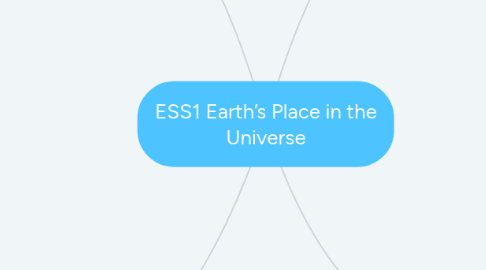
1. ESS1.B: EARTH AND THE SOLAR SYSTEM
1.1. What are the predictable patterns caused by Earth’s movement in the solar system?
1.1.1. Solar System
1.1.1.1. The Sun
1.1.1.1.1. Planetary motions around the sun can be predicted using Kepler’s three empirical laws, which can be explained based on Newton’s theory of gravity
1.1.1.2. Collection of objects of varying sizes and conditions—including planets and their moons
1.1.1.2.1. Held in orbit around the sun by its gravitational pull on them
1.1.1.2.2. System appears to have formed from a disk of dust and gas, drawn together by gravity
1.1.1.3. Earth and the moon, sun, and planets have predictable patterns of movement
1.1.1.3.1. Pattern has explainable by gravitational forces and conservation laws, in turn explain many large-scale phenomena observed on Earth
2. ESS1.C: THE HISTORY OF PLANET EARTH
2.1. How do people reconstruct and date events in Earth’s planetary history?
2.1.1. Earth scientists use the structure, sequence, and properties to reconstruct events in Earth’s planetary history
2.1.1.1. Rocks
2.1.1.1.1. Analyses of rock formations and the fossil record are used to establish relative ages
2.1.1.1.2. Core samples obtained from drilling reveal that the continents’ rocks (some as old as 4 billion years or more) are much older than rocks on the ocean floor (less than 200 million years), where tectonic processes continually generate new rocks and destroy old ones
2.1.1.1.3. The rock record reveals that events on Earth can be catastrophic, occurring over hours to years, or gradual, occurring over thousands to millions of years
2.1.1.1.4. active geological processes, such as plate tectonics (link to ESS2.B) and erosion, have destroyed or altered most of the very early rock record on Earth, some other objects in the solar system, such as asteroids and meteorites, have changed little over billions of years
2.1.1.2. Sediments
2.1.1.3. Fossils
2.1.1.3.1. Analyses of rock formations and the fossil record are used to establish relative ages
2.1.1.4. locations of current and past ocean basins, lakes, and rivers
2.1.1.4.1. geological time scale organizes Earth’s history into the increasingly long time intervals of eras, periods, and epoch
3. What is the universe, and what is Earth’s place in it?
3.1. Earth is a tiny part of a vast universe
3.1.1. Developed over a huge expanse of time
3.2. History of the universe, and of the structures and objects within it, can be deciphered using observations of their present condition together with knowledge of physics and chemistry
3.3. Patterns of motion of the objects in the solar system can be described and predicted on the basis of observations and an understanding of gravity
3.3.1. Comprehension of these patterns can be used to explain many Earth phenomena
3.3.1.1. day and night
3.3.1.2. seasons
3.3.1.3. tides
3.3.1.4. phases of the moon
3.3.2. Observations of other solar system objects and of Earth itself can be used to determine Earth’s age and the history of large-scale changes in its surface
4. ESS1.A: THE UNIVERSE AND ITS STARS
4.1. What is the universe, and what goes on in stars
4.1.1. Sun is but one of a vast number of stars
4.1.1.1. Milky Way galaxy
4.1.1.1.1. One of a vast number of galaxies in the universe
4.1.2. The sun is a medium-sized star about halfway through its predicted life span of about 10 billion years
4.2. Universe began with a period of extreme and rapid expansion known as the Big Bang, which occurred about 13.7 billion years ago
4.2.1. Big Bang
4.2.1.1. theory is supported by the fact that it provides explanation of observations of distant galaxies receding from our own
4.2.1.1.1. Measured composition of stars and non-stellar gases, and of the maps and spectra of the primordial radiation (cosmic microwave background) that still fills the universe
4.2.2. Nearly all observable matter in the universe is hydrogen or helium, which formed in the first minutes after the Big Bang
4.2.2.1. Elements other than these remnants of the Big Bang continue to form within the cores of stars
4.2.2.1.1. Stars’ radiation of visible light and other forms of energy can be measured and studied
4.2.2.2. Nuclear fusion within stars produces all atomic nuclei lighter than and including iron, and the process releases the energy seen as starlight
4.2.2.3. Heavier elements are produced when certain massive stars achieve a supernova stage and explode
